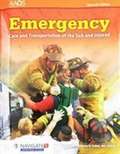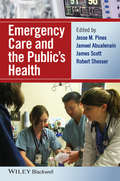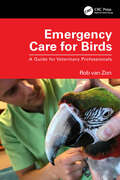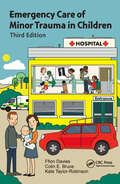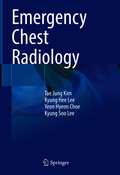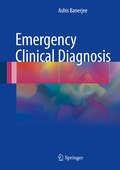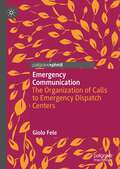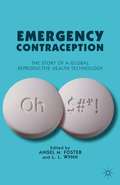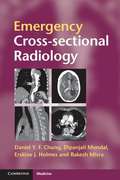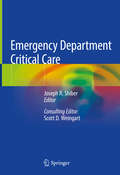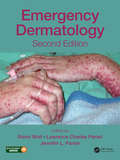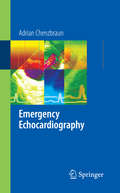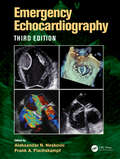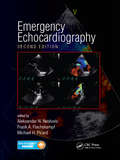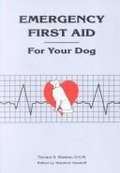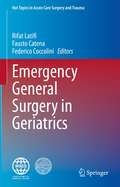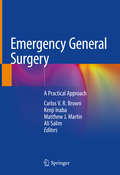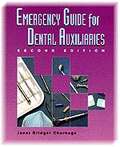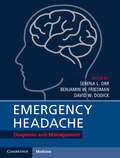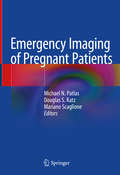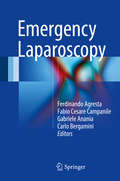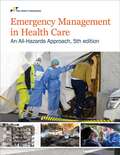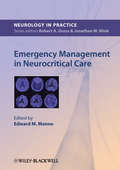- Table View
- List View
Emergency Care and Transportation of the Sick and Injured (Eleventh Edition)
by American Academy of Orthopaedic SurgeonsNavigate 2 Advantage Access unlocks a complete eBook, Study Center, homework and Assessment Center, a dashboard that reports actionable data, and Fisdap Scheduler and Skills Tracker. Experience Navigate 2 today at www. jblnavigate. com/2. In 1971, the American Academy of Orthopaedic Surgeons (AAOS) published the first edition of Emergency Care and Transportation of the Sick and Injured and laid the foundation of EMS training. Today, the Eleventh Edition transforms how EMS education is delivered throughout the world and helps develop world-class EMS providers around the globe. Based on the National EMS Education Standards and the 2015 CPR/ECC Guidelines, the Eleventh Edition offers complete coverage of every competency statement with clarity and precision in a concise format that ensures students' comprehension and encourages critical thinking. New cognitive and didactic material is presented, along with new skills and features, to create a robust and innovative EMT training solution. Today, the AAOS suite of EMS educational resources, from first aid and CPR to critical care transport, is the gold standard in training programs by offering exceptional content and instructional resources that meet the diverse needs of today's educators and students. Current State-of-the-Art Medical ContentThe Eleventh Edition aligns with current medical standards--from PHTLS to NASEMSO--and incorporates evidence-based medical concepts to ensure students and instructors have accurate, insightful interpretation of medical science as it applies to prehospital medicine today. Application to Real-World EMSThrough evolving patient case studies in each chapter, the Eleventh Edition gives students real-world context to apply the knowledge gained in the chapter, clarifying how the information is used to care for patients in the field, and pushing students to engage in critical thinking and discussion. A Foundation for LifeThe Eleventh Edition is built on the premise that students need a solid foundation in the basics and then appropriate reinforcement. The Eleventh Edition provides students with a comprehensive understanding of anatomy, physiology, pathophysiology, and medical terminology. Concepts are briefly reviewed within related subsequent chapters, solidifying the foundational knowledge and offering a context when studying specific emergencies. Patient Assessment, a critical topic, is presented as a single, comprehensive chapter, to ensure students understand patient assessment as a single, integrated process--the way providers actually practice it in the field. Core concepts of Patient Assessment are reinforced in clinical chapters, where the unique aspects of the illness or injury are highlighted.
Emergency Care and the Public's Health
by James Scott Robert Shesser Jameel Abualenain Jesse M. PinesAs US health care systems undergo a period of transformative change, so too will emergency care, and more specifically emergency departments. This transformation will include: The development of new diagnostic, therapeutic, and information technologiesA growing need to prepare and respond to emerging public health threatsThe expansion of the role of allied health professionals to address the workforce crisisNovel expectations for care coordinationThe fundamental economics of emergency care under new payment models, andThe key relationship with American law.Emergency Care and the Public's Health explores the complex role of emergency care in the context of these changes and as an increasingly vital component of health care systems both within and outside the US.From an expert emergency medicine team, this new title is a reference for emergency care and critical care providers, allied health professionals and hospital administrators. It is also for relevant for public policy and healthcare policy professionals.
Emergency Care for Birds: A Guide for Veterinary Professionals
by Rob van ZonDue to their often small size and unique physical characteristics, birds can deteriorate rapidly in the event of illness and injury. Timely intervention in the event of clinical signs is therefore essential for an optimal prognosis. Authored by avian veterinarian Rob van Zon, this concise, practical guide will help veterinary professionals to provide first aid and emergency care for birds, as well as to instruct clients on providing basic first aid when they are unable to get to the clinic. This full-color book, packed with photographs and anatomy drawings, includes instructions for veterinary professionals on stabilizing sick avian patients and management of many specific emergency situations at the veterinary clinic. This includes guidance for those presented with a moribund, critically ill patient i.e., recognizing and treating hypothermia, hypoxia, hypovolemia and hypoglycemia. The book also lists of alarming signs of disease and toxic plants, and includes clinical procedures, an emergency drug formulary, and bandaging techniques. Finally, it offers guidance to veterinarians giving advice to bird owners for first aid at home.
Emergency Care of Minor Trauma in Children
by Ffion Davies Colin E. Bruce Kate Taylor-RobinsonSuccinct and highly illustrated, the third edition of this handy pocket guide enables practitioners to successfully manage common minor injuries in children at the point of care. Each chapter has been updated to reflect changes to the treatment for the injury based on recent research and new guidelines. The new edition includes: the latest recommended guidelines and procedures, for instant access to key information generous use of colour, warning boxes, icons, clinical tips and practical advice to help the reader find information at a glance numerous illustrations help explain more difficult concepts detailed guidance on when to treat, how to treat, when to refer or when minor trauma is indicative of a more serious diagnosis. This concise evidence-based book remains an essential purchase for junior doctors, nurse practitioners and emergency care practitioners in the emergency department, minor injury centre or primary care facility. It is a touchstone for all those seeing children following minor injury or trauma.
Emergency Chest Radiology
by Kyung Soo Lee Kyung Hee Lee Tae Jung Kim Yeon Hyeon ChoeThis book provides an up-to-date, comprehensive review of every aspect of emergency chest radiology in patients who are admitted to emergency departments with chest trauma or chest pain. The aim is to offer an unsurpassed source of practical information on imaging diagnosis of acutely ill and injured patients with this symptomatology. To this end, the wide spectrum of chest and cardiovascular emergencies are systematically categorized and typical imaging manifestations of these emergent conditions are illustrated in superb detail, with particular attention to the role of state of the art imaging techniques. The book will be an ideal resource for all members of the emergency team, general and emergency radiologists, radiology residents, and medical students.
Emergency Clinical Diagnosis
by Ashis BanerjeeThe aim of this book is to help the reader achieve the correct diagnosis in the emergency setting, which continues to remain a challenge, given the variety of potential clinical presentations. Diagnostic failure is the largest reason for delays in provision of appropriate treatment, which can be life-saving, and the largest source of clinical complaints and untoward incidents leading to poor clinical outcomes and to litigation. In this book, the readers will find diagnostic checklists, organised according to potential emergency presentations and classified under body systems, including atypical presentations, lists of differential diagnoses and guidance to pattern recognition. Apart from providing an aide-memoire for a range of presentations, it is hoped that the book will allow for better quality and informed referrals, especially between health care providers. This book is aimed as a rapid reference guide for all levels of medical staff working in emergency and acute care settings in the English-speaking world, but may also benefit nursing professionals and medical students.
Emergency Communication: The Organization of Calls to Emergency Dispatch Centers
by Giolo FeleThis book explores communication in emergency call and response centers, taking an approach drawn from Conversation Analysis to examine how call-takers answer calls and the ways in which dispatch is issued in different contexts. It offers an original contribution to the study of the organization of emergency calls, the ways such calls are treated, and some of the practical problems that emerge when dealing with them. The author offers a systematic review of studies in the international field of the organization of emergency calls, while at the same time providing fresh case studies, illustrated with empirical materials, taken from audio- and video- recordings of the everyday activities of call and response centers. This book will be of interest to students and scholars of social interaction and may be appreciated by all scholars and practitioners working on the social management of emergency situations, including in fields such as Sociolinguistics and Pragmatics.
Emergency Contraception
by L. L. Wynn Angel M. FosterDespite its safety and efficacy, emergency contraception (EC) continues to spark political controversy worldwide. In this edited volume, authors explore how emergency contraception has been received, interpreted, and politicized, through the in-depth examination of the journey of EC in 16 individual countries.
Emergency Cross-sectional Radiology
by Dipanjali Mondal Erskine J. Holmes Rakesh Misra Daniel Y. ChungCross-sectional imaging plays an ever-increasing role in the management of the acutely ill patient. There is 24/7 demand for radiologists at all levels of training to interpret complex scans, and alongside this an increased expectation that the requesting physician should be able to recognise important cross-sectional anatomy and pathology in order to expedite patient management. Emergency Cross-sectional Radiology addresses both these expectations. Part I demystifies cross-sectional imaging techniques. Part II describes a wide range of emergency conditions in an easy-to-read bullet point format. High quality images reinforce the findings, making this an invaluable rapid reference in everyday clinical practice. Emergency Cross-sectional Radiology is a practical aide-memoire for emergency medicine physicians, surgeons, acute care physicians and radiologists in everyday reporting or emergency on-call environments.
Emergency Department Critical Care
by Scott D. Weingart Joseph R. ShiberThis comprehensive book provides practical guidance on the care of the critical patient in the emergency department. It focuses on the ED physician or provider working in a community hospital where, absent the consulting specialists found in a large academic center, the provider must evaluate and stabilize critically ill and injured patients alone. Structured in an easily accessible format, chapters present fundamental information in tables, bullet points, and flow diagrams. Emergency medicine scenarios covered across 38 chapters include acute respiratory failure, spinal cord Injuries, seizures and status epilepticus, care of the newborn, and end-of-life care.Written by experts in the field, Emergency Department Critical Care is an essential resource for practicing emergency physicians and trainees, internists and family physicians, advance practice nurses, and physician’s assistants who provide care in emergency departments and urgent care centers.
Emergency Department Leadership and Management
by MPH Philip D. Anderson MPH Robert Freitas MHA Stephanie Kayden Mph Elke Platz Robert Freitas Mha Elke PlatzEmergency departments around the world may differ, but many of the problems they face are the same. Written by an international panel of experienced emergency department leaders Emergency Department Leadership and Management provides the latest knowledge and advice to improve your personal leadership skills. The book will assist emergency department leaders in overcoming common management and operational problems including overcrowding, risk management, implementing the right triage system, electronic and IT solutions, improving clinical teamwork, education of emergency department staff, improving patient flow, care pathways and leading during times of change. Example cases are included to allow leaders to compare common cases to the problems which they face in their own departments. Information on designing emergency medicine specialty residency programs is also provided. It is the official text of the International Emergency Department Leadership Institute (IEDLI) and has been endorsed by the International Federation for Emergency Medicine (IFEM).
Emergency Dermatology
by Lawrence Charles Parish Batya B. Davidovici Jennifer L. Parish Ronni WolfMany physicians and patients do not believe that dermatology involves life-threatening situations. However, there are many emergencies that the dermatologist needs to address and many cutaneous diseases in the emergency room that require rapid dermatologic consultation. The dermatologist is frequently the first physician to examine these patients before a hospital admission, and also the first to identify a critical situation, stabilize the patient, and choose urgent and appropriate intervention. The first chapters of this book are directed toward those dermatologists who care for hospitalized patients with severe and dangerous skin diseases. Later chapters are intended for all physicians, including dermatologists, who wish to hone their diagnostic skills, expand their knowledge and understanding of pathological events, and learn treatment options available for acute life-threatening skin diseases. This book brings together top dermatologists around the world to address the complicated and multifaceted field of dermatologic emergencies for the practising dermatologist and emergency physician.
Emergency Dermatology
by Ronni WolfThere are many emergencies that the dermatologist needs to address and many cutaneous diseases in the emergency room that require rapid dermatologic consultation. The dermatologist is frequently the first physician to examine such patients before a hospital admission and also the first to identify a critical situation, stabilize the patient, and choose urgent and appropriate intervention. Both the practicing dermatologist and the emergency physician will benefit from the revised and updated edition of this text from top international dermatologists, enabling them to hone their diagnostic skills, expand their knowledge and understanding of pathologic events, and learn treatment options available for acute life-threatening skin diseases in this complicated and multifaceted field.
Emergency Echocardiography
by Adrian ChenzbraunEchocardiography is still relatively underused in the management of critically ill and hemodynamically unstable patients. There is a definite trend for favoring echocardiography over invasive assessment in intensive care units, however, clear guidelines are lacking. The author's experience over the last few years reinforced the importance of a book covering this topic. The basis for the creation this book was the fruit of teaching sessions and ward rounds during which the interest and receptiveness for this topic were obvious.
Emergency Echocardiography
by Aleksandar N. Neskovic Frank A. FlachskampfEchocardiography is the most powerful and cost-effective imaging technique for assessing patients suffering from unstable cardiovascular diseases. This didactically structured third edition of Emergency Echocardiography contains fully rewritten chapters by well-known, internationally recognized contributors. It includes new chapters on echo-guided patient management in the ICU, lung ultrasound, and complications of percutaneous interventions. Special attention is given to Focus Cardiac Ultrasound (FoCUS) in emergency settings. The book uses over 600 video loops of illustrative cases to interest a wide readership of all medical professionals involved in diagnostics and treatment of emergency cardiovascular patients. Key Features Covers the role of cardiac ultrasound in most cardiovascular emergencies and emergency settings Offers clinically useful information to a wide range of medical professionals dealing with cardiovascular emergencies, including cardiologists, emergency physicians, anesthesiologists, intensivists, and related fellows Features over 600 carefully chosen videos of illustrative cases with detailed explanations and highlights key decision management points
Emergency Echocardiography: Principles And Practice
by Aleksandar N. Neskovic, Frank A. Flachskampf and Michael H. PicardEchocardiography is the most cost-effective and versatile imaging technique for assessing patients suffering from unstable cardiovascular diseases. Since 2005, emergency echocardiography has been recognized as a specific field, with particular implications to education, training, and reporting. Emergency Echocardiography covers the topic and completely updates existing chapters. This second edition utilizes a user friendly new pedagogy and contains new topics of interest to the widening readership from professionals from various specialties, e.g. cardiologists, emergency physicians, anesthesiologists, intensivists and fellows. New chapters address emerging topics, including training and educational requirements and provides online learning materials that comprise more than 450 video loops and illustrative case scenarios.
Emergency First Aid for Your Dog
by Stanford Apseloff Tamara S. ShearerThe authors present a host of information to prevent your dog from requiring emergency care. But sometimes, despite our best efforts, accidents and injuries happen. This is a must have resource for anyone who is loved by and loves their dog. It includes basic first aid as well as very in depth information on how to care for your dog in an emergency situation. Do you know how to choose toys that won't hurt your dog? Do you know which plants are toxic or possess toxic parts? It also covers other common poisons...when to induce vomiting, when not too... An excellent written guide for caring for your pooch until emergency vet care can be obtained. No dog owner should be without this book.
Emergency General Surgery in Geriatrics (Hot Topics in Acute Care Surgery and Trauma)
by Rifat Latifi Fausto Catena Federico CoccoliniThere is a growing need for a book on emergency general surgery in the elderly, as adults age 65 and older are the fastest growing segment of the population worldwide, and their number is expected to double to 89 million between now and 2050. Based on these changing demographics, it is expected that there will be a concurrent rise in the demand for a variety of surgical services, including vascular surgery (with a projected growth of 31%) and general surgery (with a projected growth of 18%), as well as in all sub-disciplines of surgery (thoracic, cardiac, oncology, hepatobiliary, transplant, plastic colorectal, orthopedic, gynecologic, urology and neurosurgery).In addition, older surgical patients often require a different level of care than younger patients during the preoperative, intraoperative and postoperative phases. Many of our geriatric population have multiple chronic illnesses beyond the one for which surgery is required, and therefore are prone to developing postoperative complications, functional decline, loss of independence, and other undesirable outcomes. In response, this book offers surgeons, geriatrists and nurses state-of-the-art surgical approaches and essential information on the complex perioperative care of the elderly.
Emergency General Surgery: A Practical Approach
by Matthew J. Martin Ali Salim Kenji Inaba Carlos V. BrownThe field of emergency general surgery encompasses a wide array of surgical diseases, ranging from the simple to the complex. These diseases may include inflammatory, infectious, and hemorrhagic processes spanning the entire gastrointestinal tract. Complications of abdominal wall hernias, compartment syndromes, skin and soft tissue infections, and surgical diseases are significantly complex in special populations, including elderly, obese, pregnant, immunocompromised, and cirrhotic patients.This book covers emergency general surgery topics in a succinct, practical and understandable fashion. After reviewing the general principles in caring for the emergency general surgery patient, this text discusses current evidence and the best practices stratified by organ system, including esophageal, gastroduodenal, hepatobiliary and pancreatic, small and large bowel, anorectal, thoracic, and hernias. Chapters are written by experts in the field and present a logical, straightforward, and easy to understand approach to the emergency general surgery patient, as well as provide patient care algorithms where appropriate.Emergency General Surgery: A Practical Approach provides surgeons and surgery residents with a practical and evidence-based approach to diagnosing and managing a wide array of surgical diseases encountered on emergency general surgery call.
Emergency Guide for Dental Auxiliaries (Third Edition)
by Janet B. ChernegaMedical emergencies can and do occur within the dental office environment. A large percentage of these emergencies could be prevented or at least better treated if all the members of the dental team were more knowledgeable in the prevention and management of emergency situations. Emergency Guide for Dental Auxiliaries, 3e is designed to provide dental auxiliaries with the basic skills and knowledge necessary in order for them to function effectively as part of the dental team when faced with a medical emergency. A must for all dental auxiliaries working in dental offices to stay up to date on possible medical emergencies, First Aid skills, and important information on the legal aspect of emergency care in the dental office. (key words: dental, dentist, dental auxiliaries, dental emergency, dental assisting)
Emergency Headache: Diagnosis and Management
by Friedman David W. Orr Serena L. Benjamin W. DodickDo you need current and pragmatic guidance in meeting the challenges of acute headache assessment under pressure? Authored by renowned experts in neurology and emergency medicine, this versatile handbook offers practitioners a broad perspective on common, less-common, and rare headache disorders to enable accurate patient diagnosis and effective treatment. Featuring a multidisciplinary team of authors, this textbook provides clinicians who work in acute care settings with the right tools to recognise and understand primary headache disorders and life threatening causes of headache. Covering the best available evidence and practice standards from the emergency department, this guide provides direct answers to challenging management problems. Invaluable and extensively researched, practitioners are able to confidently evaluate a spectrum of conditions, while balancing resource utilization and cost considerations in a time-constrained environment.
Emergency Imaging of Pregnant Patients
by Mariano Scaglione Douglas S. Katz Michael N. PatlasThis book presents a comprehensive and modern approach to the imaging of nontraumatic and traumatic emergencies in pregnant patients. Readers will find a careful review of the relevant imaging-related clinical literature, explanation of imaging appropriateness criteria and guidelines, and enlightening discussion of current controversies in the emergency imaging of obstetric patients. The opening chapter discusses general principles of emergency imaging during pregnancy and offers an overview of an evidence-based approach to imaging interpretation. The remainder of the book describes specific applications of ultrasound, MRI, radiography, and MDCT for the imaging of common as well as less common acute brain, spine, thoracic, abdominal, and pelvic conditions during pregnancy. Clear guidance is offered on the unique challenges that may be encountered during such imaging. Emergency Imaging of Pregnant Patients is written by a group of leading North American and European emergency and trauma radiology experts. It will be of value to emergency and general radiologists, to emergency department physicians and related personnel, to obstetricians and gynecologists, to general and trauma surgeons, and to trainees in all of these specialties.
Emergency Laparoscopy
by Ferdinando Agresta Fabio Cesare Campanile Gabriele Anania Carlo BergaminiThis book provides up-to-date evidence on laparoscopic emergency surgery and supplies concrete advice on when and how to approach patients laparoscopically in an emergency setting. All the diseases elegible for emergency laparoscopy are addressed, and for each disease recommendations, levels of evidence, and technical key points are discussed and analyzed. Diagnostic flow charts are included for cases in which laparoscopy turns out to be the final diagnostic step and the first therapeutic one. Furthermore, problematic and positive aspects of the laparoscopic approach from the anesthesiologic point of view are fully explored. Finally, a useful overview of current practice in hospitals across the world is provided, highlighting the varying applications in relation to different medical "cultures", skills, resources, and healthcare systems.
Emergency Management In Health Care, An All-hazards Approach, 5th Edition
by Joint Commission ResourcesPublic health crises, such as COVID-19, natural disasters from wildfires to tornados, and human-caused emergencies, including mass shootings and cyberattacks, have been on the rise in recent years, putting health care organizations on high alert. Because of the unpredictability of emergencies, The Joint Commission champions an all-hazards approach to emergency management (EM), reflected in its requirements. Emergency Management in Health Care: All All-Hazards Approach, 5th edition, is a comprehensive, up-to-date resource to help all types of health care organizations plan for a wide range of emergencies. This new edition has been completely revised to reflect The Joint Commission’s new “Emergency Management” chapter for hospitals and critical access hospitals (effective July 1, 2022) and continues to address the EM planning needs of all health care settings.
Emergency Management in Neurocritical Care
by Edward M. MannoRapid response, assessment and management are crucial for neurocritical situations Acute neurological illness is traumatic for patients and their families. Physicians caring for these patients are often under great distress and need to rapidly assess the situation to allow appropriate stabilization and management. Emergency Management in Neurocritical Care gives you the tools you need to perform under pressure in the neurocritical or emergency care unit. The no-nonsense approach corresponds to the attitude needed in both acute emergencies and in the neurocritical care unit. Packed with handy tips to improve your care of patients, and written by internationally renowned experts, the book covers: Acute Management of Neurological Emergencies Cerebrovascular Critical Care Infections of the Nervous System Neuromuscular Complications Encountered in the Intensive Care Unit Neurological Complications and Consultations in General Intensive Care Units Acute Neuroimaging and Neuromonitoring in Neurocritical Care Clinical in approach, practical in execution, Emergency Management in Neurocritical Care will help you perform better in pressure situations.
